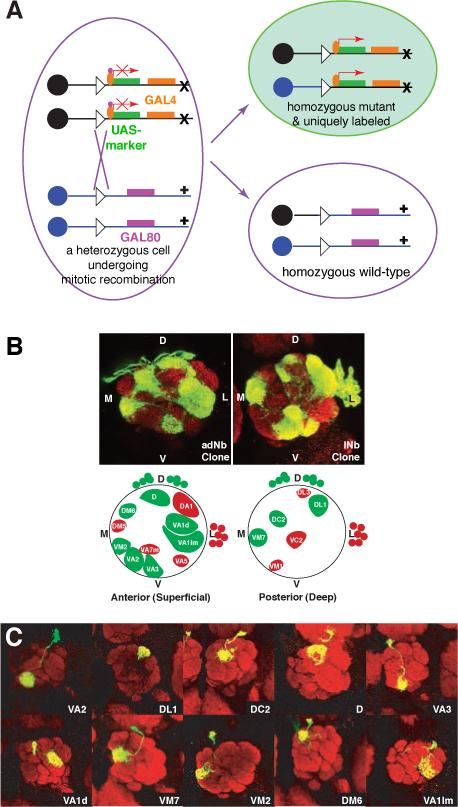Fig. 1.

MARCM-based clonal analysis revealed relationship between lineage/birth order and wiring specificity of olfactory projection neurons. (A) Schematic of MARCM. After FLP/FRT site-specific mitotic recombination (cross between triangles), a heterozygous mother cell may give rise to two daughter cells, in which the chromosome arms distal to the FRT recombination site (triangle) become homozygous. GAL80 is ubiquitously expressed and efficiently suppresses GAL4-dependent expression of a UAS-marker gene. If GAL80, but not GAL4 or UAS-marker, is inserted on the chromosome arm carrying the wild-type (+) gene of interest, the daughter cell homozygous for the mutant gene (x) no longer contains GAL80. Therefore, the marker gene can be specifically turned on by GAL4 in homozygous mutant cells. Magenta rectangles and ovals indicate the GAL80 transgene and GAL80 protein respectively; Orange rectangles and ovals indicate the GAL4 transgene and GAL4 protein, respectively. Adapted from Lee and Luo (2001). (B) Anterodorsal and lateral neuroblast clones (adNb and lNb clones) contain PNs with stereotypical and complementary glomerular projections, as revealed by these single confocal sections of an anterodorsal (left) and a lateral (right) neuroblast clones taken at similar depths. Bottom panels show schematic of landmark glomeruli derived from anterodorsal (green) and lateral (red) neuroblasts in the anterior or posterior sections of the antennal lobe. D: dorsal; V: ventral; M: medial; L: lateral. Large circles indicate the antennal lobe. Glomeruli are structures inside the antennal lobe with specific names. Green and red circles outside and dorsal or lateral to the antennal lobes indicate adPN or lPN cell bodies, respectively. (C) Representative images of the 10 single cell MARCM clones of projection neuron induced at progressively later developmental stages, that project dendrites to 10 distinct glomeruli as indicated. Modified after Jefferis et al. (2001).
